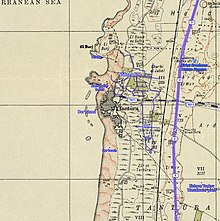Nahsholim
Nahsholim
נַחְשׁוֹלִים | |
|---|---|
 Nahsholim | |
| Coordinates: 32°36′51″N 34°55′17″E / 32.61417°N 34.92139°E | |
| Country | Israel |
| District | Haifa |
| Council | Hof HaCarmel |
| Affiliation | Kibbutz Movement |
| Founded | June 1948 |
| Founded by | Turkish Jewish immigrants and Israeli residents |
| Population (2022)[1] | 704 |
Nahsholim (Hebrew: נַחְשׁוֹלִים, lit. 'Tidal waves') is a kibbutz and beach resort in northern Israel. Located near Zikhron Ya'akov, it falls under the jurisdiction of Hof HaCarmel Regional Council. In 2022 it had a population of 704.[1]
History
[edit]
The kibbutz was established in June 1948 by a group of idealistic Zionists who settled in the Palestinian village of al-Tantura a few weeks after the previous residents were expelled after a massacre by Jewish forces.[2] The earliest residents were Palmach members, but were soon joined by Holocaust survivors from Poland.[2] In 1949 the residents wrote:
- [W]e settled in Tantura and did not have to work much in order to start [a new life], only to use what existed here already... The beginning was the day when our group "Nahsholim” came and settled on the lands of the abandoned village Tantura and in its houses. The village was deserted. The property was abundant, and it was the time of the year to gather the crops. And these crops—listen, I shall not exaggerate if I say that we were somewhat dazed—the soil was fertile, the conditions comfortable, the sea and the beach incomparable, and overall [there were] limitless possibilities. We saw our dream coming true...[2]

The spacious former home of the mukhtar of Tantura served as the dining room.[2] Other houses served as residences or as cowsheds, chicken coops or stables, workshops and sheds.[2] Over the next decade, most of the houses of Tantura were destroyed and new buildings constructed on the northern side.[2] The residents had wished to establish the kibbutz as a fishing village on El Burj, the site of ancient Dor, but gave up after a long fight with the Israeli Department of Antiquities.[2] Today, according to a report in the newspaper Haaretz, a car park for the beaches of Nahsholim and neighboring Dor contains a mass grave from the 1948 Tantura massacre.[3]
Economy
[edit]A glass bottle factory founded by Baron Rothschild in 1891 is located in Nahsholim.[4] Today it is an archaeological museum with displays of objects found in the excavations at Tel Dor since 1980. In 2015, archaeologists examining remains of a shipwreck discovered in 1976 off Dor Beach, near Zichron Yaakov, announced that it was probably a ship sent by Rothschild with supplies for the bottle factory.[5] Also exhibited in the museum are a large assortment of anchors, jars and navigational tools retrieved by the center's diving team. Cannons, swords, guns and ammunition have been found underwater, dating from the retreat of Napoleon’s armade in 1799.
The kibbutz grows bananas, avocado and cotton, and raises fish in ponds. It also operates a plastics factory that manufactures irrigation equipment.[6]
Notable residents
[edit]References
[edit]- ^ a b "Regional Statistics". Israel Central Bureau of Statistics. Retrieved 21 March 2024.
- ^ a b c d e f g Confino, Alon (2015). "The warm sand of the coast of Tantura: History and Memory in Israel after 1948". History & Memory. 27: 43–82. doi:10.2979/histmemo.27.1.43.
- ^ a b Adam Raz, 'There's a Mass Palestinian Grave at a Popular Israeli Beach, Veterans Confess,' Haaretz, 20 January 2022.
- ^ HaMizgaga Museum Archived 2008-06-29 at the Wayback Machine
- ^ "Shipwreck off Israel's coast, long unidentified, linked to early Zionist". Jewish Telegraphic Agency. August 15, 2015. Retrieved April 24, 2019.
- ^ Rosovsky, Nina (May 20, 1990). "Israel's Kibbutz Guesthouses". The New York Times. Retrieved April 24, 2019.


